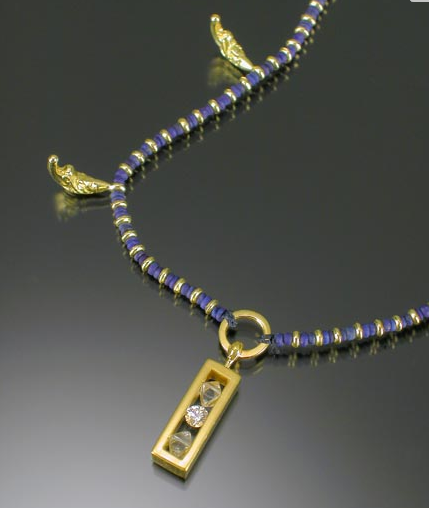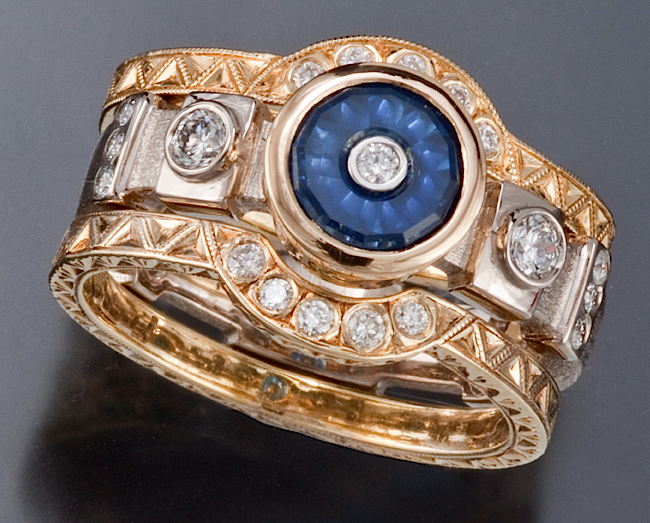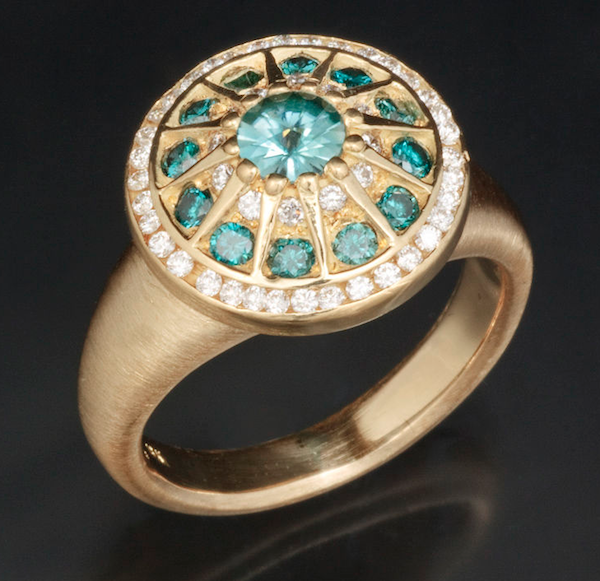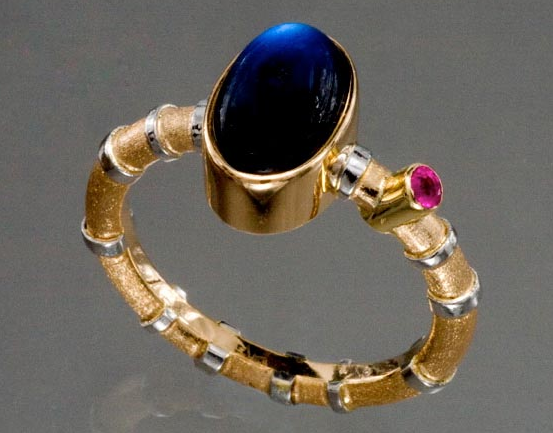
Sky and water often come up in discussions of blue. Topaz, boulder opal, and chrysocolla are the Mediterranean through a snorkeling mask. Blue chalcedony and certain iolites look like a hazy eastern sky. Turquoise and azurite are more like the sky over the desert or the Rockies. Tanzanite is dusk, lapis a moonlit night.
These correlations have been around since ancient civilization and jeweler Douglas Zaruba believes jewelry designers have a unique opportunity to tap into that if they combine elements effectively.
Like sky and water, blue was considered somewhat elusive historically, being one of the most difficult colors to produce from natural materials. The ancient Egyptians found effective, if somewhat expensive, methods of creating ultramarine pigment by crushing lapis imported from Afghanistan and “Egyptian blue” by heating malachite with sand, chalk, and soda.
Americans and Western Europeans are particularly fond of blue. Blue sapphire, tanzanite and topaz have long been among the top selling stones in the U.S.
Sapphire we think of as a deep, true blue – considered in the gem industry to be its “proper color” – and Zaruba works with that, as with the Torus cut below. But he finds the “secondary” shade of purple-blue sapphire even more interesting – and considerably less expensive. “It’s something like tanzanite, only much harder,” he says. “Which means I can use it in rings.”

Brittany ring of Torus-cut .96ct sapphire, diamond, 18k gold, 14k white gold by Douglas Zaruba (vortex13.com)
Jewelers have the ability to affect a stone’s hue dramatically with their metalwork. Zaruba uses yellow gold for the warmer blue-green stones. “But if I’m going for a cool look with an icy blue aquamarine cut in a geometric shape, I may use platinum.” He also finds that using white diamonds as accent stones makes a blue register more strongly.

He’s been known to correlate stones in his jewelry to the four elements of ancient Greek alchemy: earth, wind, air, and fire. “Historically, the stones used for the water element are aquamarine and beryls,” says Zaruba. “Aquamarine has that brilliant silver flash to it – kind of a moist cold. For air, topaz and chalcedony are the traditional stones. Chalcedony is a warmer silver-blue. The metal for water is silver and when you combine the blue and the silver it makes you think of moonlight on water.”

Zaruba finds moonstone particularly ethereal. “If you walk along the shore in Sri Lanka, the beaches are covered with moonstones, tumbled by the surf,” he says. He tells me a tale he heard from an Indian stone dealer: “Legend has it that if you place a blue moonstone between your lips during a blue moon and make a wish with your feet in the ocean, the object of your heart’s desire will come to you. It’s the lover’s stone.”
Inspired by this fable, Zaruba once made a ring of blue moonstone and ruby for a friend. “Ruby is the heart stone,” he explains. “So when you place this ring between your lips, it’s like Cupid with two arrows.” His friend took her ring into the ocean near her California home and made a wish. “Within a year, she fell in love and got married,” he says. “Coincidence? I don’t think so.”

By the standard definition of a blue moon – second full moon in a calendar month – we’re not due for one until 2015. But by definition of the Maine Farmers’ Almanac (third full moon in a season of four full moons, seasons marked by three-month intervals between solstices and equinoxes – phew!), a blue moon is due on August 21, 2013.
“So, all you lovers out there, grab your moonstones and head for the beach,” Zaruba advises. “If everybody does this, with all those people standing there on the beach in the moonlight, you’re bound to find somebody!”
To see more cool jewels designed by Doug Zaruba, visit his website or (better yet) his gallery at 35 N. Market Street in Frederick, MD.
Related posts:
Why blue diamonds are blue: recent tests on the Hope Diamond
Top 10 jewelry designers on the Loupe in 2012
How to photograph gems: tips from the pros
Related products (Buying through links on this site doesn’t cost you any extra but it puts a couple bucks toward maintenance of this blog):

